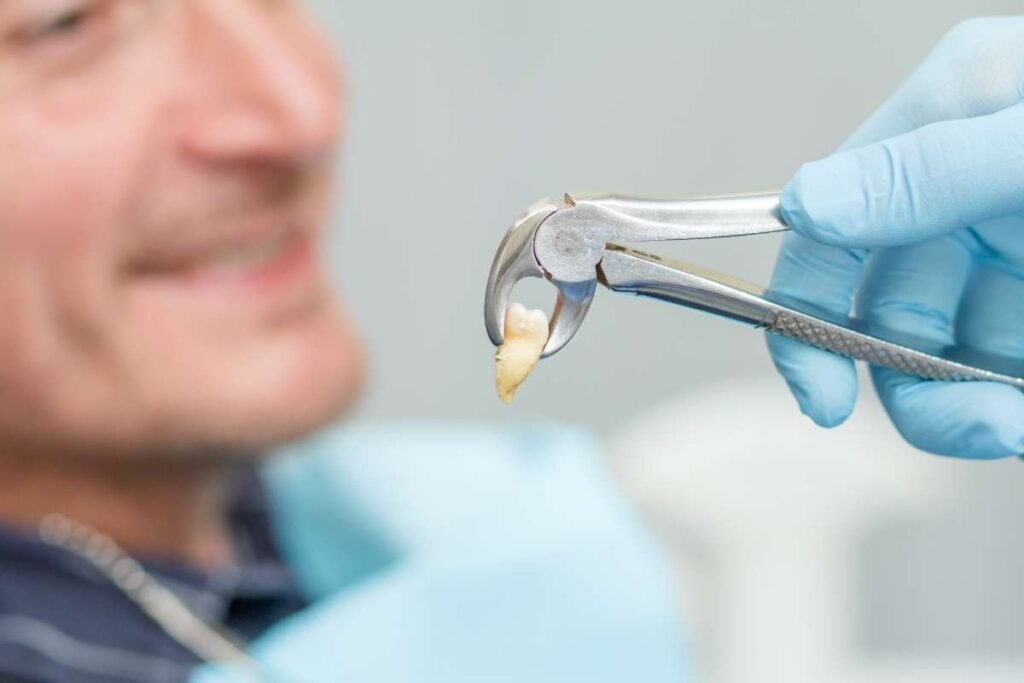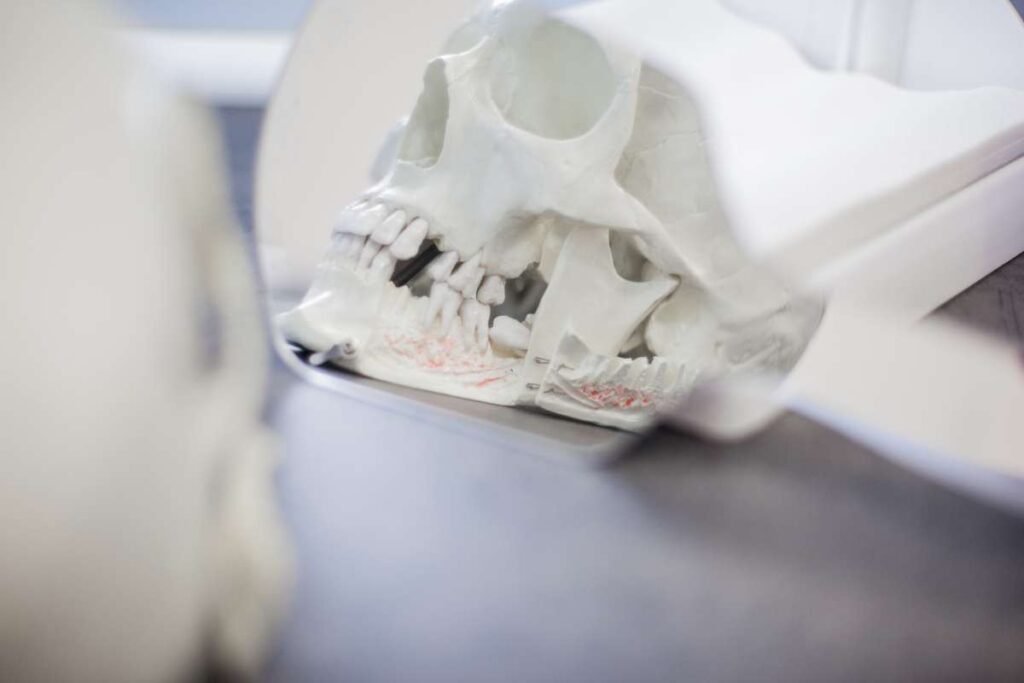Table of Contents
Losing a tooth is an event that many people tend to underestimate, especially if it’s a back tooth that isn’t visible. However, ignoring the loss of a tooth can have serious long-term consequences on your oral and overall health.
In this article, we will explore the consequences of not treating missing teeth and why it is important to visit your dentist as soon as possible for an evaluation and appropriate treatment.
Changes in facial structure and bone loss
One of the most significant effects of tooth loss is the loss of bone in the affected area. When a tooth is lost, the surrounding jawbone begins to deteriorate because it is no longer stimulated by the pressure exerted during chewing. This phenomenon is known as bone resorption and can lead to a significant reduction in bone volume over time.
Bone loss not only compromises the stability of neighboring teeth but can also impact the overall facial structure. The support provided by the jawbone is essential for maintaining the shape of the face. When this support is lost, the face may appear sunken, aged, and less toned. The cheeks may look hollow, and the lips less full, contributing to an older appearance.
Difficulty in chewing and digestion
The loss of one or more teeth can make chewing food more difficult and less effective. Each tooth plays a specific role in the chewing process, and the absence of one can compromise the ability to properly break down food. This can lead to less efficient digestion since the food is not sufficiently chewed before swallowing.
Poor digestion can cause a range of gastrointestinal problems, including indigestion, heartburn, and constipation. Additionally, the difficulty in chewing certain foods may result in a less varied and balanced diet, limiting the intake of essential nutrients for overall health.
Movement of adjacent teeth
The teeth surrounding a missing tooth tend to shift in an attempt to fill the empty space. This movement can cause a range of issues, including irregular tooth alignment (malocclusion) and the formation of gaps between teeth. Shifting teeth can become harder to clean, increasing the risk of cavities and gum disease.
Malocclusion can also negatively impact chewing function and the aesthetics of the smile. In severe cases, it can cause jaw pain, headaches, and other issues related to the temporomandibular joint (TMJ).
Increased risk of gum disease
The loss of a tooth can significantly increase the risk of developing gum disease. When teeth shift to fill the empty space, the gums around the remaining teeth may recede, creating pockets where plaque and bacteria can accumulate. These pockets are difficult to clean with a toothbrush and floss, increasing the risk of gum inflammation (gingivitis) and, ultimately, periodontitis.
Periodontitis is a severe gum infection that can lead to the loss of other teeth and the deterioration of the jawbone. Timely treatment of missing teeth can help prevent the onset of these complications.

Pronunciation problems and difficulty speaking
Teeth play a crucial role in the formation of certain sounds during speech. The loss of a tooth, especially the front ones, can affect the ability to pronounce certain letters and words correctly. This can cause difficulties in communication, leading to embarrassment and frustration.
People who lose one or more teeth may notice that their voice sounds different or that they have to make more effort to pronounce certain words correctly. In some cases, this can impact their self-esteem and quality of life.
Psychological impact and quality of life
Losing one or more teeth can have a significant impact on self-confidence and quality of life. Many people feel embarrassed about their appearance and may become less inclined to smile or participate in social situations. This can lead to social isolation, depression, and anxiety.
A smile is often considered one of the most important aspects of a person’s appearance, and its absence can have a devastating effect on self-perception. Treating missing teeth with solutions such as dental implants, bridges, or dentures can help restore not only function but also aesthetics, greatly improving the quality of life.
Issues with stability and wear of remaining teeth
When a tooth is lost and not replaced, the remaining teeth are subjected to greater chewing load. This can lead to accelerated wear of the remaining teeth, making them more susceptible to cavities, fractures, and other dental problems. Additionally, teeth that shift to fill the space left by the missing tooth may become less stable and more prone to further shifting or even falling out.
Treatment options for missing teeth
It is important to know that there are several options for treating missing teeth and preventing the negative consequences described above. These options include:
Dental Implants
Dental implants represent one of the most advanced and reliable solutions for replacing missing teeth. They are particularly effective because they mimic the natural structure of a tooth. A dental implant consists of a titanium post that acts as an artificial root, which is surgically inserted into the jawbone where the missing tooth once resided. Titanium is used because it is biocompatible, meaning it can integrate seamlessly with the bone through a process called osseointegration.
Once the implant has fully integrated with the jawbone, it becomes a sturdy foundation capable of supporting a dental crown, bridge, or even a full denture. This integration not only provides a secure and permanent solution but also helps maintain the jawbone’s integrity by stimulating it similarly to a natural tooth. This prevents the bone loss typically associated with missing teeth, preserving the facial structure and preventing the sunken appearance that can occur over time.
Dental implants are versatile and can be used to replace a single tooth, multiple teeth, or even to secure full dentures, offering a long-term solution that restores both function and aesthetics. This makes them an excellent choice for patients looking to restore their smile and maintain their oral health after tooth loss.
Dental Bridges
Dental bridges are a common and effective solution for replacing one or more missing teeth. A dental bridge is a fixed prosthesis designed to fill the gap left by missing teeth, restoring both the function and appearance of your smile. The bridge consists of one or more artificial teeth (called pontics) that are anchored to the adjacent natural teeth, known as abutment teeth.
The abutment teeth are typically prepared by reducing their size to accommodate crowns that will support the bridge. These crowns are then cemented onto the abutment teeth, securely holding the bridge in place. The pontics fill the space where the missing teeth were, creating a seamless appearance and restoring the ability to chew and speak properly.
Dental bridges are particularly advantageous because they are a non-removable option, offering a stable and durable replacement for missing teeth. They help maintain the alignment of surrounding teeth, preventing them from shifting into the gap, which could lead to bite issues and other dental problems.
This type of restoration is an excellent choice for patients who prefer a fixed solution and may not be suitable candidates for dental implants. A dental bridge can restore your smile and maintain your oral health by preserving the alignment and function of your remaining teeth.
Removable Dentures
Removable dentures, commonly known as false teeth, offer a versatile and non-permanent solution for replacing missing teeth. Unlike fixed prosthetic options, dentures can be easily taken out and reinserted by the wearer, providing flexibility and convenience in daily oral care.
Dentures come in two main types: partial and complete. Partial dentures are designed to replace only some missing teeth, filling in gaps and preventing the surrounding natural teeth from shifting. They typically consist of replacement teeth attached to a gum-colored plastic base, which is held in place by metal clasps that anchor to the remaining natural teeth.
Complete dentures, on the other hand, are used when all the teeth in an upper or lower arch are missing. These dentures rest directly on the gums and are custom-made to fit the contours of the mouth, providing a natural appearance and restoring the ability to chew and speak properly.
While removable dentures may require an adjustment period, they are an affordable and non-invasive option for many patients. They can significantly improve the quality of life by restoring functionality and aesthetics to the smile. Additionally, modern dentures are designed to be more comfortable and natural-looking, making them a popular choice for those who need a full or partial replacement of their teeth.
Fixed Dentures on Implants
This option, known as implant-supported dentures, merges the stability of dental implants with the full coverage of a complete denture. Unlike traditional removable dentures, which rest on the gums and may shift or slip, implant-supported dentures are anchored securely to dental implants placed in the jawbone. This creates a more stable and reliable solution, significantly enhancing comfort and functionality for the wearer.
The use of dental implants provides a firm foundation, preventing the common issues associated with removable dentures, such as movement during eating or speaking. This option also helps maintain the jawbone’s health by stimulating it through the implants, reducing the risk of bone loss that typically occurs with missing teeth.
However, each treatment option comes with its own set of pros and cons. The choice of the most suitable solution depends on various factors, including the number of missing teeth, the condition of the jawbone, the patient’s overall oral health, and their budget. Implant-supported dentures, while offering superior stability and longevity, may involve a higher initial cost and require sufficient bone density for implant placement.

Prevention is key for maintaining oral health
Prevention is always the best strategy for maintaining optimal oral health. Taking care of your teeth and gums with proper oral hygiene, regular dental visits, and a balanced diet can significantly reduce the risk of tooth loss.
If you have lost a tooth or multiple teeth, it is essential to address the situation as soon as possible. Ignoring a missing tooth can lead to a cascade of problems that may require complex and costly treatments in the future. Investing in the replacement of missing teeth will not only improve your oral health but also have a positive impact on your overall health and psychological well-being.
Why do we need to take care of replacing missing teeth?
Not treating missing teeth can have a range of negative consequences that go beyond the aesthetics of your smile. From jawbone deterioration to digestive issues, speech difficulties, and self-esteem problems, the repercussions of tooth loss can be severe and long-lasting. Fortunately, there are several solutions available to replace missing teeth and prevent these complications. Consulting a dentist to discuss treatment options is the first step towards maintaining a healthy mouth and a confident smile.
The importance of promptly treating missing teeth cannot be underestimated. If you are experiencing this situation, do not hesitate to seek professional advice. With the right care and attention, it is possible to restore the function and aesthetics of your smile, while also improving your quality of life.





